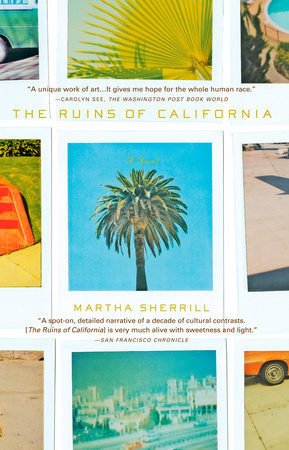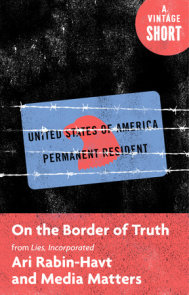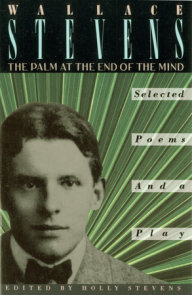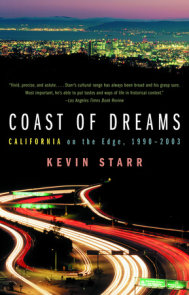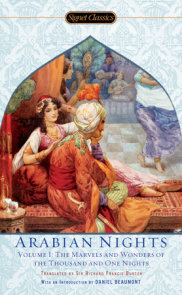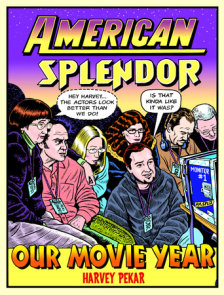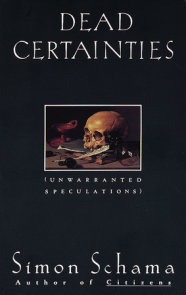READERS GUIDE
Questions and Topics for Discussion
INTRODUCTION
The Ruins of California
“This novel is for those who love their families with a terrible love and prize filial piety above all things, even though that family—and it’s bound to be overextended—appears bound straight for hell in several different handbaskets…I’m crazy about The Ruins of California. It gives me hope for the whole human race.” —Carolyn See, The Washington Post Book World
According to the precocious Inez, life for the Ruin family in 1970s California is complex. Her father, Paul, is self-obsessed, intrusive, opinionated, and profligate, but also brilliant, adoring, magnetic, and liberating. Unable and unwilling to sustain a monogamous relationship, he’s divorced from Inez’s mother, Connie, and claims that he will never marry again, since “marriage is a bad deal for everyone—particularly women.” His intriguing personality and movie-star good looks draw women to him. Inez bears constant witness to the never-ending string of girlfriends that her father loves and then leaves.
Inez is in constant flux between two worlds—one represented by her mother, Connie, an ex-star flamenco dancer, and Connie’s mother, Abuelita, a Peruvian immigrant who works devotedly as a housekeeper for a recording-industry executive. The other holds Paul’s mother—old-money grandmother Ruin, who invites Inez for horse-riding outings and tea parties that are really lessons in refinement. Shuttled back and forth between an innocent, sedate life with Connie and Abuelita in the L.A. suburbs to premature, though thrilling, extravagances with her father in San Francisco, Inez attempts to find a home that is somewhere between the extremes.
As Inez progresses through high school, we are witness to the preoccupations of the era’s typical Californians: drugs, sex, art, surfing, love beads, Nixon, motorcycles. Inez encounters them all in her climb toward maturity, culminating in a trip to Hawaii, where she slides perilously into a drugged oblivion. She makes it out in time, but her beloved half brother is not so lucky—and Inez grows more than she thought possible as she patiently, with love and determination, saves her brother and finds herself.
Martha Sherrill reconstructs time and place in absolute pitch-perfect detail, remarkably rendering an exhilarating and confusing decade of American life.
“A spot-on, detailed narrative of a decade of cultural contrasts…very much alive with sweetness and light.” —San Francisco Chronicle
“Like a happy marriage between Joan Didion and Jane Austen.” —Geraldine Brooks, Pulitzer-prize-winning author of March and Year of Wonders
“An absolutely note-perfect portrayal of California in the ’70s.” —Minneapolis Star-Tribune
“Readers hungry for a coming-of-age story…will warm to Martha Sherrill’s The Ruins of California, a vibrant patchwork of a novel.” —Elle
“Technically perfect characterization in a tale that explores an imperfect family.” —Kirkus
“Sherrill’s re-creation of California in the ’70s is impeccable, and her story of how a girl trapped in a theatrical family manages to transform herself from an observer into the star of her own life is absolutely irresistible” —Booklist (starred review)
ABOUT MARTHA SHERRILLMartha Sherrill is also the author of The Buddha from Brooklyn, a work of nonfiction, and My Last Movie Star, a novel. She was raised in Los Angeles and now lives in Massachusetts with her husband and son.
DISCUSSION QUESTIONSIn many ways, Inez Ruin, the narrator of The Ruins of California, and her family capture the bifurcated landscape of America, and especially California, in the 1970s: divorced mother and father; struggling workers and the unfettered rich; waning liberal hippies and rising conservative Reaganites; the “smug” north of old Beat poets and the “smooth” south of sprawling suburbs and Hollywood; and, of course, white and Latino. As a young child, Inez seems to imagine that her Ruin half is the future. How does she handle the schisms in her identity, and how do her choices in life reflect the social, racial, and economic divides in America over the past generation?
Martha Sherrill draws on many real locales in The Ruins of California, from the bohemian bars of Telegraph Hill in San Francisco to the seaside cottages (and the Jolly Roger restaurant) of Laguna Beach. Yet, Inez’s hometown, Van Dale, does not exist, nor does San Benito, where her grandmother, Marguerite, lives; they are amalgams of several Southern California communities, likely modeled after the Los Angeles suburbs of Glendale and San Marino. As Carolyn See observed, “nothing but a little town called Eagle Rock, a bridge aptly named Suicide and the town of Pasadena separate these two worlds—merely a 20-minute drive.” What does this mix of fictional and real geography convey about the way Inez perceives her identity? How does their close geographical proximity yet great cultural distance influence Inez’s sense of self?
Sherrill opens the book with a quotation from Shakespeare’s The Tempest. Does her father, Paul Ruin, serve as a marvelous, magical Prospero who introduces lnez to a modern American “brave new world”? How does the comparison illustrate the trajectory of Paul and Inez’s relationship as Inez grows into a young woman?
When Inez first meets her half-brother, Whitman, she notes how he refers to their father by his “whole name, Paul Ruin—the weight of it bearing down on him” (p. 34). What does Whitman’s formality convey about his relationship to his parents and his ancestry? Does Inez experience the weight of the Ruins differently as a girl? Paul’s second-born? Connie’s half-Latina daughter?
Why does Paul insist that he’s “not interested in getting married again [or] into marriage…that it doesn’t work [and] is a bad deal for everybody—particularly women” (p. 72)? How do his feelings about commitment—and his string of girlfriends, which Inez can’t help but think includes her mother since “it was necessary to leave eventually, and find somebody else” (p. 298)—shape Inez’s relationship with her father? How and why do Inez’s feelings toward his girlfriend of longest standing, Justine, change over the course of the novel? By the end of the book, does Inez still believe that her father “had searched the world over and finally found a girl he liked most of all: me” (p. 6)?
Vibrant descriptions of sixties and seventies fashions—Inez’s dorky camp fire girls uniform and white clodhoppers, the English riding britches and chic hand-me-down cashmere poncho, slack low-rider cords battling preppie khaki skirts, a Da Kine camisole—constantly pop up in Inez’s remembrances, and she even notes that she “was always standing slack-jawed in front of the closet” wondering, ‘what could I wear? Who would I be?’” (p. 61) How and why might we turn to clothing to help define ourselves?
The 1970s Californian obsession with “being real” slowly infiltrates the novel, from Paul’s abandoning his lovesick airport greetings (p. 64) to Connie’s devotion to the psychological super-introspection of est. What does “being real” mean to Inez, Whitman, Paul, Connie, and Justine? When Inez does decide to reveal the “unguarded me,” what does she disclose and what does she decide to protect about her family’s story? Is not making a big deal out of anything specific to the book’s setting, or is it an essential ingredient in the Ruin family life? In family life in general?
By the time Inez is twelve, she’s been exposed to the somewhat secret lives, and needs, of adults. Connie jettisons tango for tennis in her search for love with coach Weeger (p. 50). She learns about Connie’s father, Charles Garcia, though she notes that she’s left out a few parts of the story that her mother denied (p. 95). Her father buddies up with Whitman to smoke marijuana on the car ride home from the airport (p. 79). When she herself is invited into the adult world by her father, she notes, “I tried but couldn’t tell Robbie about the grass—or much else of what happened…she wouldn’t have understood or approved” (p. 133). To Inez, what separates childhood from adulthood—beyond “the fun accessories” (p. 241)? Why does she decide that she cannot share the journey to adulthood with her childhood friend, Robbie?
Inez says that her maternal grandmother, Abuelita, “didn’t like to waste too much time on dreams” (p. 92)—including her star-crossed romance with Charles Garcia. What does Abuelita’s story, as a recent immigrant to the United States, disclose about California’s and Inez’s history? How does it compare to Marguerite’s mythological rendering of the Ruin ancestors?
At various moments in the novel, Inez grapples with her changing body—and the attitudes toward her emerging womanhood conveyed by her two families, her friends, and the boys and men who desire her. Her father teases her about her modesty: “Is that a bra you’re wearing, Inez?…Don’t you know that women all over the world are burning theirs?” (p. 97), while fast-living Shelley tweaks her about her neeplus erectus. How do the various women and men in Inez’s life shape her consciousness about her body and her larger sense of womanhood?
As Connie becomes enamored of Werner Erhard’s est, one of the most popular of the self-help movements to take root in California during the 1970s, she pushes Inez to adopt a new view of her personal relationships, decisions, and responsibility, including one of Erhard’s mantras, “everything was programming, and people were just machines”(p. 156). What draws Connie to est, and what makes Inez reject her mother’s newfound, “simplistic” introspection? How does Inez’s attitude toward her own story compare?
When Inez witnesses Marguerite’s death at the Arroyo, she does so through a haze of drug-induced as well as adolescent confusion. Does she feel responsible for the accident? How does she relate to her father and the Ruin family after the death? What is the significance of Inez’s flashback of the Arroyo cotillion at the moment when Marguerite’s life seems to hang in the balance (p. 181)?
Inez receives a great deal of advice from her wealthy father about money, “money has a funny power on people” (p. 26). Why does Paul have such conflicted feelings about money, from his family inheritance to his financial success in Silicon Valley? Why do you think he gives Inez the counsel he does?
What lessons does Inez learn about love and sex from her parents? As she is contemplating having sex for the first time, what makes her decide against a liaison with Ooee in favor of waiting for the “right person”? Is this a sign that Inez is maturing? Why, when she falls for David, does she say “it’s like having another job” (p. 250)? And does Inez’s psychoanalytic summary of love—“Freud said it was a decision made so far into you, in the dark, that it wasn’t the result of reason….Thing of urges, and needs, and fears” (p. 297)—apply as much to the love people extend to their families as to their romantic partners? How does it extend, for example, to Inez’s relationship with Whitman? With Paul? With others?
When Inez takes up photography, she seems to blossom. It’s her first interest independent of Paul, Connie, and Whitman, and, though she takes it up because other people tell her she’s “a born photographer,” she develops a real interest in it (p. 255). What does Inez learn about herself through her photography?
As a teenager, Inez is granted great freedom, bequeathed to her by her free-living father and her lost-soul mother. Is she trapped by this freedom? How? In what ways does Inez’s adolescence encapsulate America’s hangover from the libertine late 1960s?
At the end of the novel, Inez must outstrip her father’s self-centered, prolonged adolescence and realize that she alone will have to step up to the responsibilities of adulthood. What allows her to stop the crisis that is unraveling in Whitman’s, and her family’s, life? How does Inez’s rescue compare to her father’s intervention when she herself is falling into a “flatlining and floating” existence (p. 284)? Why does Inez say “it wasn’t brave or anything like that” to save her brother (p. 295)?
Why does Sherrill choose to have Inez narrate the events of her life from the shifting perspective of her girlhood rather than look back on them from the vantage of adulthood? In what ways does Inez’s answer to her question “how does a girl grow up?” (p. 60) differ as she gets older? At the end of the novel, Robbie, exclaims, “you sound exactly the same,” and she replies, “I am” (p. 315). To what extent are our personalities set in childhood or reshaped by major life events? Is it possible to stay the same, as Inez says she has?
In a column published in the San Francisco Chronicle, Martha Sherrill revealed that she had once planned to write a memoir based on her relationship with her father, “a high-living North Beach bachelor with a string of sensational girlfriends.” She realized, however, that “the story could only be told faithfully if [she] were freed from the rules of nonfiction, the first of which is: tell the truth.” What expectations do we bring to books that are united by genres such as: nonfiction, memoir, and fiction? Sherrill goes on to note that so-called “autobiographical fiction” piques and allures many readers, who “demand…to know which parts of the novel are ‘real,’” why do we put so much emphasis on “real events” over fictional ones? Do you feel a story is more powerful if it is nonfiction or if it is fiction? Why?









